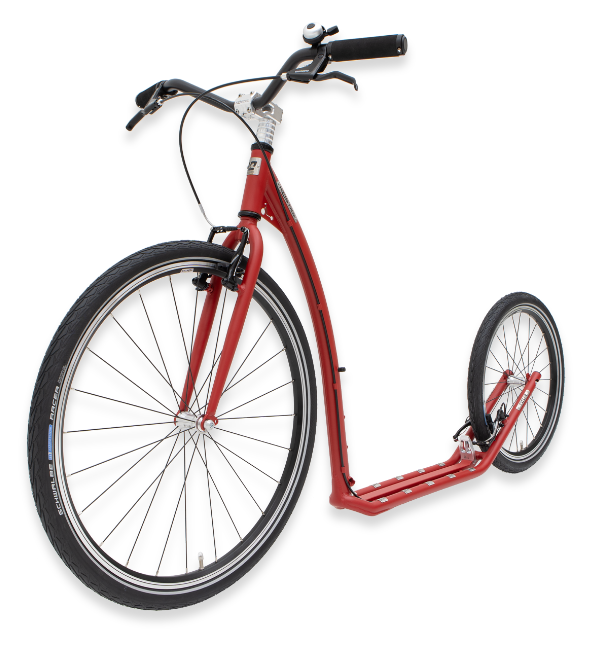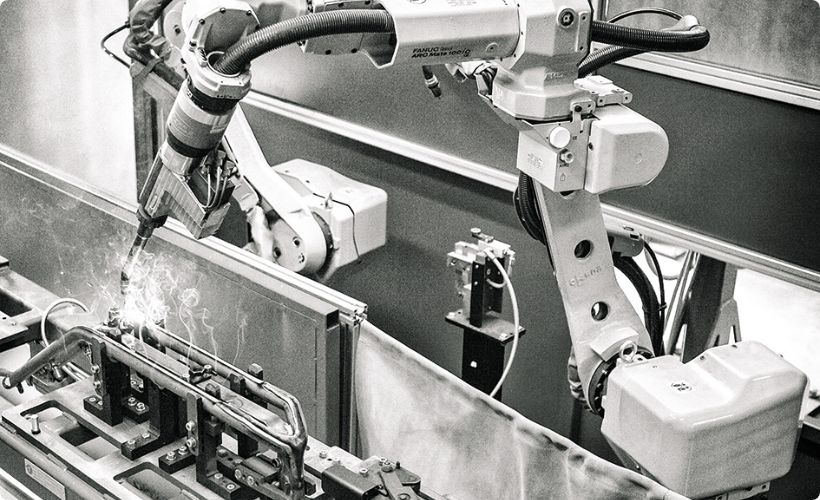


How is a footbike made?
The footbike was invented many years ago – and its simplicity continues to be its main strength. The principle is clear: two wheels connected by a deck and supplemented with handlebars and brakes. Even though the principle behind the footbike has not changed over the years, there is still much that can be improved. Unlike bicycles, we constantly have to grapple with the rigidity of the open frame and footbikes also have a number of other specific characteristics that you will not find elsewhere. We work on them constantly and tirelessly.
We are not trying to reinvent the wheel - that was done many years ago
Footbike construction also has its own rules and laws. We respect them and as such we do not innovate simply for innovation's sake. Design is not only a matter of appearance – it also has to be highly functional. The footbike has already been invented. It is up to us to improve it.
When humans befriend robots
We naturally endeavour to use the latest technology during production, as it renders production more efficient. However, manual work is often irreplaceable in many cases. We don’t live in a sci-fi film; we simply create footbikes as well as possible.
We keep your safety in mind
Our footbikes meet the conditions for use on public roads; it is our responsibility to provide our customers with a safe machine. Flawlessly functioning brakes and passive safety components are a matter of course in every KOSTKA model.
Tested on humans. Including Karel
Our test riders conscientiously test out every new feature on our footbikes. As does Karel – that is an electromechanical test bench with a computer controlled and evaluated output. Karel never gets tired and it’s impossible to put one over on him… Karel says how a footbike works with utmost precision.
KOSTKA footbike production technology
It all sounds so simple: You have an idea for a footbike in your head. You “dump” it into your computer and then find out what material and components you will need. As this is not your first rodeo, you know which technology to use to process the material and how to join it all together. Suddenly, you are presented with a really long list of things to do. And it all has to be packed to travel all around the world. Luckily, we know how to get all this done. All of it.

Computers instead of drawing boards
The basic concept must combine our customers’ requirements with our know-how and vision and the entire complex then has to be transformed into a functioning artefact. The initial idea is always the brainchild of a clever individual, but the subsequent work is done by a computer.
Once the basic parameters have been set, the ideas are transferred into a parametric computer model. There, it is possible to test out theoretical ideas and to determine the footbike’s suitable geometry. The anatomy of the human body is also entered into the model, so that it is possible to investigate the influence of the footbike’s geometry on the rider’s posture. The critical points are then subjected to detailed computer simulation (FEM) and optimised from the point of view of both their shape and function so that they comply with all the designated boundary conditions.

Precise 3D laser cutting
Precisely cut parts constitute the foundation of any flawless product. Laser processing is unconventional technology that allows the creation of diverse shapes with a high degree of precision and without any burrs. Laser cutting enables us to work with parts that can otherwise only be produced with great difficulty or are practically impossible to produce using conventional technology.
Our own 3D laser cutting technology enables us to come up with new structural solutions and thus to not be limited to just the classic shapes and notches of the individual profiles. Our TRUMF TUBE 5000 laser machines can also burn aluminium and other alloys and have efficient 3D cutting heads and special measuring technology for even greater precision.

We can tie a knot in a tube!
… or 3D spatial bending in practice
Most of the parts in the footbike’s frame are spatially shaped. Put simply… the tubes are bent. It’s easy to say “a bent tube”, but just try doing it precisely and then identically in a series of thousands of items.
The use of 3D CNC controlled bending machines means, however, that we can make spatially complicated bends with guaranteed dimensional stability. This technology and the special tools limit the negative effects of shaping on the individual bends.

Robotic, but also manual…
… welding of the highest quality
If we want to produce the very best footbikes, it is also necessary to focus on the stability of the thermal effect on the welded areas and also on the adherence to the technological procedures. Our three robotic arms are capable of very efficient, top-flight production and welds that are otherwise extremely difficult to achieve. However, even robots would be nothing other than a piece of expensive furniture that gathers dust without talented programmers and welders.
Despite the fact that we are equipped with the latest robotic welding technology, there are certain joins on the footbike that are still welded by hand with the highest degree of precision possible. Human work is sometimes simply irreplaceable.

CNC machining
… we create the footbike components
Our machining centre means that we do not have to rely on component suppliers, as other footbike manufacturers do. As such, we can produce parts that have been specially designed for footbikes – and that is precisely what we do.
We produce our own top-flight wheel hubs with the correct width for the footbike frames and our machining centre produces our designer stems in fixed and collapsible variants – and that is how we wish to continue. We have an original solution for you that has been made to measure for footbikes.

Laser marking…
… or a permanent record
We can, of course, recognise the components that we have invented and produced at our CNC machining centre at a glance. However, we also mark them with indelible laser engraving just to make sure. Every artist signs their work :-)

As far as wheels are concerned…
… we also make our own
Our automated lines also produce perfect wheels that are flawlessly centred and have precisely tightened spokes. This means that every wheel is absolutely identical and precisely complies with the requirements placed upon it.
We work with radial or cross spokes with various methods of affixing the wires to the hubs of our own design as needed. We purchase rims and spokes from proven manufacturers of good repute so that we can also guarantee our wheels with a clear conscience.

The appearance doesn’t make the footbike go any faster, but the colour is still important for all that
We have our very own paint shop. The fact that we have a welding robot is great, but its work has to be balanced with an effective paint job – only then is there really something to look at. After all, you wouldn’t want to ride a footbike that you didn’t like the look of…
All the footbikes are powder coated with multiple coats at out cutting edge powder coating paint shop. This means that they not only have a unique design, but are also highly resistant to all external influences and mechanical abrasion. We have also developed special technology for the application of paint to the internal parts of the frame – this provides increased resistance against any penetrating water, especially during rain.

We don’t sell construction kits
… we produce finished footbikes
Our work doesn’t end with the production of the individual components. If you were to break our footbikes down into their constituent parts, you would find an average of 220 parts. Some of the parts are assembled at automated workstations (for example, the spoke wiring line for the wheels), but the entire footbike still has to be put together.
nd not only put together, but also checked for functionality and tuned in relation to all its components. Everything then has to be packed up so that the footbike arrives at your door without incurring any damage during transport. You only need to fit the handlebars and then… you’re off!